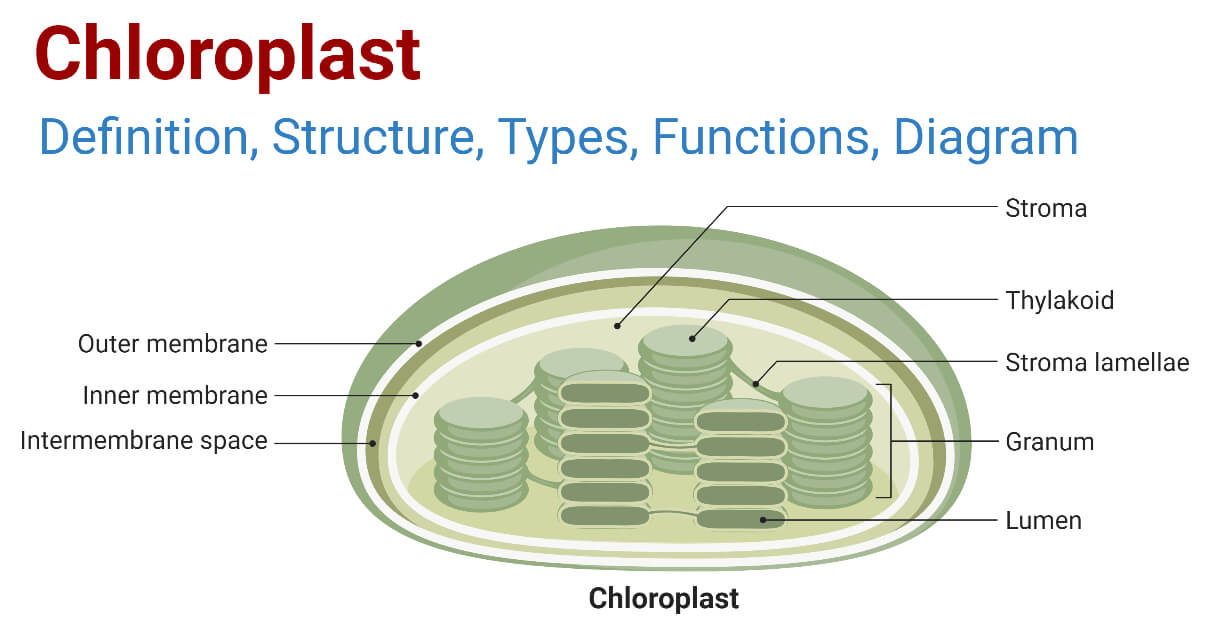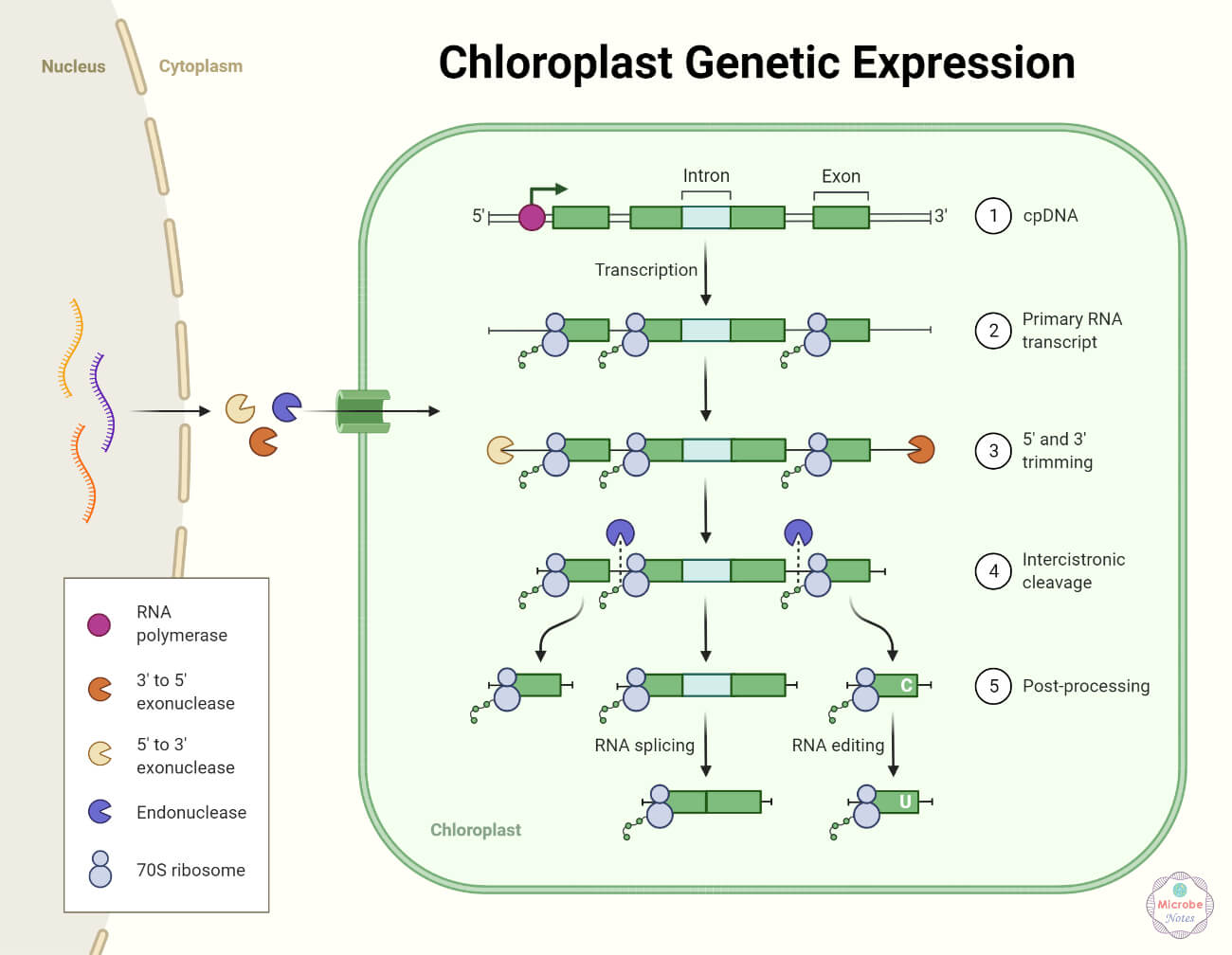The word chloroplast is derived from the Greek words chloros, which means green, and plastes, which means “the one who forms”.
Chloroplasts are membrane-bound plastids that contain a network of membranes embedded into a liquid matrix and harbor the photosynthetic pigment called chlorophyll.
- It is this pigment that imparts a green color to plant parts and serves to capture light energy.
- Chloroplasts can be found in the cells of the mesophyll in plant leaves.
- There are usually 30-40 per mesophyll cells.

Interesting Science Videos
Chloroplast Morphology
- Its size and shape vary from species to species. In higher plants chloroplast are generally biconvex or planoconvex.
- However, in different plant cells, it may have various shapes such as filamentous, saucer, ovoid, discoid, spheroid, star-like girdle-shaped, spiral ribbon-like, reticulate, or cup-shaped.
- The size of the chloroplast is generally measured at about 5-10 µm in diameter and 2-3 µm in thickness.
- The chloroplast of cells of polyploid and shade plants are comparatively larger than the chloroplast of cells of diploid and sun plants.
- From cell to cell, chloroplast’s numbers differ from one to another.
- It depends on the physiological state of the cell also. For example, Chlamydomonas has only one chloroplast however 1-16 chloroplast in Spirogyra.
- According to a calculation, Ricinus communis leaf contains about 400,000 chloroplasts per square millimeter of surface area.
- The number of chloroplast gets increased by division when it’s inadequate in number.
- Similarly, degeneration takes place when it’s excessive in number.
Types of Pigments
- Chlorophyll
- Chlorophyll is a green pigment located within the chloroplast. More specifically, it is found in the thylakoid membranes.
- The chlorophyll consists of 75% of chlorophyll a and 25% of chlorophyll b.
- The chlorophyll absorbs energy from sunlight and the synthesis of food molecules in the chloroplast.
- Carotenoids
- Carotenoids are the pigments present in chlorophylls which are located in the thylakoid membrane. Pigments like yellow and orange are present in it.
- Carotenoids are related to vitamin A.
- They are important because they can absorb a certain wavelength of light that can not be absorbed by chlorophylls.
- Carotenoids are involved in a function known as photoprotection.
- Xanthophylls
- The carotenoids are carotenes and xanthophylls. Xanthophylls are present in the brown and green algae.
- Phycobilin
- Phycobilin is found only in red algae and Cyanobacteria. It has a relatively narrow distribution.
- Phycoerythrin and phycocyanin are other accessory pigments belonging to this family.
- Phycoerythrin makes red algae commonly red and phycocyanin causes the Cyanobacteria to appear blue-green.
Structure of Chloroplasts
- Chloroplasts found in higher plants are generally biconvex or planoconvex shaped.
- In different plants, however, chloroplasts may have different shapes, varying from spheroid, filamentous saucer-shaped, discoid or ovoid-shaped.
- They can be found in the cells of the mesophyll in plant leaves. They are vesicular and have a colorless center.
- The average size of the chloroplast is 4-6 µ in diameter and 1-3 µ in thickness.
The chloroplast has an inner and outer membrane with an empty intermediate space in between. Inside the chloroplast are stacks of thylakoids, called grana, as well as stroma, the dense fluid inside of the chloroplast. These thylakoids contain the chlorophyll that is necessary for the plant to go through photosynthesis. The space the chlorophyll fills is called the thylakoid space.
A chloroplast thus has the following parts:
- Envelope (Outer membrane)
It is a semi-porous membrane and is permeable to small molecules and ions, which diffuses easily. The outer membrane is not permeable to larger proteins.
- Intermembrane Space
It is usually a thin inter-membrane space about 10-20 nanometers and it is present between the outer and the inner membrane of the chloroplast.
- Inner membrane
The inner membrane of the chloroplast forms a border to the stroma. It regulates the passage of materials in and out of the chloroplast. In addition to regulation activity, fatty acids, lipids, and carotenoids are synthesized in the inner chloroplast membrane.
- Stroma
Stroma is an alkaline, aqueous fluid that is protein-rich and is present within the inner membrane of the chloroplast. The space outside the thylakoid space is called the stroma. The chloroplast DNA chloroplast ribosomes and the thylakoid system, starch granules and many proteins are found floating around the stroma.
- Thylakoid System
The thylakoid system is suspended in the stroma. The thylakoid system is a collection of membranous sacs called thylakoids. The chlorophyll is found in the thylakoids and is the sight for the process of light reactions of photosynthesis to happen. The thylakoids are arranged in stacks known as grana. Each granum contains around 10-20 thylakoids.
Peripheral Reticulum
The chloroplasts of certain plants contain an additional set of membranous tubules called peripheral reticulum that originates from the inner membrane of the envelope. Tiny vesicles bud off from the inner membrane of the chloroplast and assemble to form the tubules of the peripheral reticulum.
Semi-autonomous nature of chloroplast
- Like the mitochondria, they are also known as semi-autonomous cell organelles as they have their DNA and complete machinery to synthesize some of the required proteins.
- While some other proteins depend upon nuclear DNA and cytoplasmic ribosomes.
- Chloroplast and mitochondria are the only two organelles having their DNA.

Functions of Chloroplasts
- Chloroplasts are the sites for photosynthesis, which comprises a set of light-dependent and light-independent reactions to harness solar energy and convert it into chemical energy.
- The components of chloroplast participate in several regulatory functions of the cell as well as in photorespiration.
- Chloroplasts also provide diverse metabolic activities for plant cells, including the synthesis of fatty acids, membrane lipids, isoprenoids, tetrapyrroles, starch, and hormones.
- Plants lack specialized immune cells—all plant cells participate in the plant response.
- The chloroplasts with the nucleus and cell membrane and ER are the key organelles of pathogen defense.
- Chloroplasts can serve as cellular sensors.
References
- Verma, P. S., & Agrawal, V. K. (2006). Cell Biology, Genetics, Molecular Biology, Evolution & Ecology (1 ed.). S .Chand and company Ltd.
- Stephen R. Bolsover, Elizabeth A. Shephard, Hugh A. White, Jeremy S. Hyams (2011). Cell Biology: A short Course (3 ed.).Hoboken,NJ: John Wiley and Sons.
- Alberts, B. (2004). Essential cell biology. New York, NY: Garland Science Pub.
- https://biologywise.com/chloroplast-structure-function
- https://alevelbiology.co.uk/notes/chloroplasts-structure-and-functions/
- https://study.com/academy/lesson/chloroplast-definition-structure-function-examples.html
- https://biologydictionary.net/chloroplast/
- https://www.microscopemaster.com/chloroplasts.html
- https://www.frontiersin.org/research-topics/5623/structure-and-function-of-chloroplasts

Thanks alot it really helped me with my biology project🙏
Thanks….
It was really helpful information
nice learn’t a lot of things from this
this is some nice work..
Nice
thank u for this wonderful explanation it was really relevant and with nice diagram…..